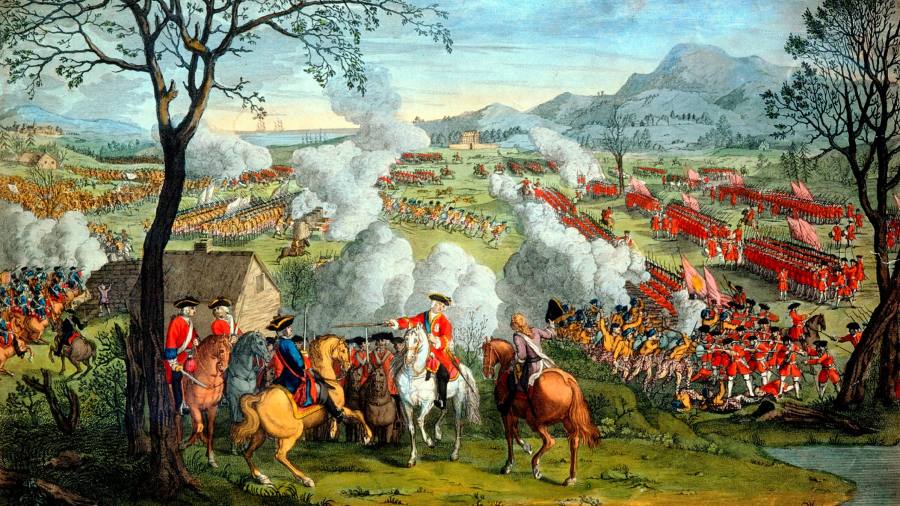[ad_1]
On the eve of the battle of Culloden in April 1746, the man who would lead the destruction of Bonnie Prince Charlie’s rebel army and the subsequent brutal repression of the Scottish clans, celebrated his 25th birthday. The portly figure of William Augustus, Duke of Cumberland, third son of the King George II, is lodged in Scottish mythology as the “Butcher Cumberlandâ€, or “Stinking Willieâ€, one of those characters whose deeds fed a sense of resentment over “English†repression that retains more than an echo in today’s push for Scottish independence.
Yet on Cumberland’s birthday on the eve of that fateful day, there were “demonstrations of joy and gladness†in Edinburgh. In Glasgow, bells were rung and toasts drunk to the duke. When he visited Edinburgh the following January, he received a hero’s welcome.
These details from Paul O’Keeffe’s book Culloden occurred barely 40 years after the 1707 Acts of Union that had joined Scotland and England politically. There was little sign back then of popular dissent in Scotland’s “central belt†that would result, 275 years later, in a majority demand for a fresh independence referendum in May’s election to the devolved Scottish Parliament in Edinburgh.
“The ’45†was the last of a series of Jacobite rebellions that sought to unseat the (Protestant) Hanovers and restore the (Catholic) Stuart line to the British monarchy. The charismatic Prince Charles Edward Stuart, also just 25, was the grandson and heir of James II.
Charles had rallied mainly Catholic Highland clans in the summer of 1745 after landing from France. Joined by lowland Episcopalians, who hated the Hanoverian-supporting Presbyterians, his army swiftly took Edinburgh and famously marched as far south as Derby, in the English Midlands, before stretched supply lines and dwindling numbers forced a tactical retreat. The uprising was to end in the last land battle fought on British mainland soil on a boggy, windswept moor between Inverness and Nairn.Â
O’Keeffe’s accounts of the key battles are detailed, vivid — and not for the faint-hearted. The Highlanders’ tactics were simple: they fired a mass volley of musket shot at enemy ranks, discarded their guns and then charged “like wildcatsâ€, wielding broadswords, axes and dirks (long-bladed daggers).
The crown forces at first crumbled in the face of this terrifying horde. The battle of Prestonpans, outside Edinburgh, was over in just 10 minutes. At Falkirk, the main fighting was done in half an hour. But the loyalist forces were by then stiffening and the story was to be very different, though not much more prolonged, at Culloden.
By then, Cumberland had taken command, reinforcing discipline and organisation. O’Keeffe details the weakening state and tactical mistakes of the Jacobites. Their numbers had shrunk, not least because many men went home for the sowing season. They had not been paid for a month and on the day of the battle had eaten just “one single biskit a manâ€.
Charles and his generals planned a night attack on Cumberland’s camp at Nairn, but they failed to reach it in time and had to march their men back to Culloden, where they arrived exhausted. Some were still asleep when the battle began at 1pm. Within the hour, there was carnage. The Highlanders’ line was askew. Many became bogged down in the wet ground, unable to mount their habitual blood-curdling charge.
They were cut down by withering grape shot and musketry. Those who reached enemy lines found themselves confronting Cumberland’s secret weapon: bayonets. Cumberland launched a merciless pursuit of the defeated rebels and followed up with a ruthless “pacification†of the Highlands. Charles disbanded his forces and, after a legendary escapade through Scotland’s western Highlands and Islands, fled back to France.
O’Keeffe goes into considerable detail on the relief and celebrations that greeted Cumberland’s victory (special pieces composed by Handel among them) and the grim fate of those brought to trial and executed. But what Culloden illustrates is how divided Scotland was by the rebellion. Cumberland’s army included five Highland companies and the Scots Fusiliers. Many families were split. Lord George Murray, one of Charles’s top generals, was the younger brother of the Duke of Atholl, who was loyal to King George.Â
It is probably a stretch to look for too much of a direct read across to Scottish politics today. The ’45 was not primarily about reclaiming independence. But as the Union faces its greatest challenge from today’s separatist movement, the country seems no less split.Â
Culloden: Battle & Aftermath, by Paul O’Keeffe, The Bodley Head, RRP£25, 432 pages
Hugh Carnegy is a senior editor at the FT
Join our online book group on Facebook at FT Books Café
[ad_2]
Source link







